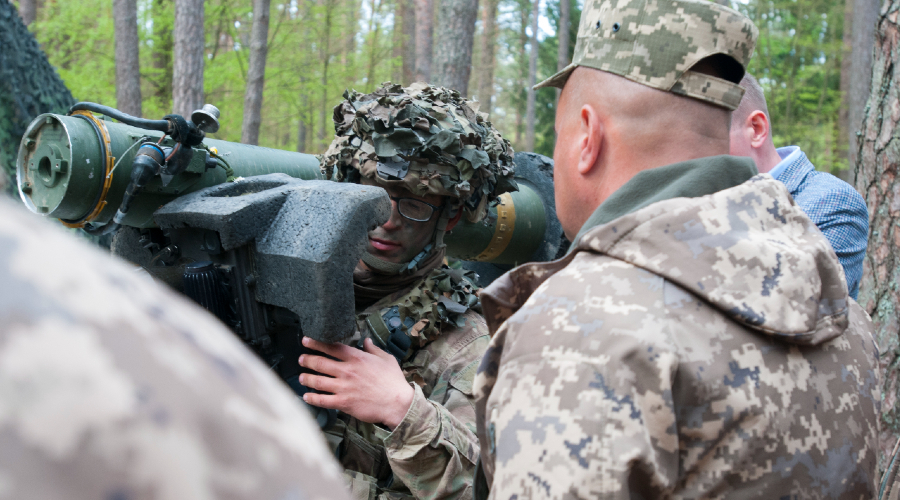Is Europe Prepared for a Proxy War With Russia?
It's not clear that countries providing support to Ukraine have considered the consequences of a long-term conflict.

Published by The Lawfare Institute
in Cooperation With

Editor’s Note: Russian forces are bogged down in Ukraine yet show no sign of ending their invasion. The United States and many European countries are pouring military aid into Ukraine, hoping to stop the Russian conquest. This short-term stalemate may devolve into a grinding proxy war. Michel Wyss of the Swiss Armed Forces’ Military Academy at ETH Zurich argues that a proxy war is already taking shape and warns of the many risks and dangers this may entail.
Daniel Byman
***
It took a mere few days for Russia’s invasion of Ukraine to upend many European conventions previously deemed sacrosanct. Not only did the European Union impose crippling sanctions against Moscow and ban Russian airplanes from its skies, but it also decided to provide Ukraine with a $503 million lethal aid package. Neutral Sweden and Finland are among the European countries sending military assistance such as anti-tank weapons, assault rifles, and surface-to-air missiles. And, in order to provide aid, Germany has made an exception to its long-standing policy of not allowing the transfer of domestically made lethal weapons into a conflict zone.
These weapons transfers will undoubtedly boost the morale of the Ukrainian defense and increase their prospects of mounting an effective resistance, at least in the short term. But beyond that, they effectively render the European countries indirect participants of the conflict in Ukraine. While this may give European Union and NATO members the appearance of “doing something” amid growing pressure and public outcry over Russia’s invasion, it also entails significant risks and costs. In other words, Europe is already in the midst of a proxy war with Russia, but it is not clear it is prepared for it.
Defining Proxy War
Proxy wars are typically defined as “the indirect engagement in a conflict by third parties wishing to influence its strategic outcome.” In a proxy war, an external sponsor supports a chosen conflict party (the proxy) through various means—such as the provision of training, weapons and funds, as well as surrogate manpower (such as Iran mobilizing militias from Afghanistan and Pakistan to fight on Assad’s behalf in Syria). Other instances of proxy support may include more direct assistance, such as intelligence sharing and operational planning, or the ability to call in airstrikes and indirect fires. This model was applied successfully in the fight against the Islamic State in Syria, where the local Syrian Democratic Forces bore the brunt of ground combat while the United States provided limited air and artillery support and had special forces personnel embedded as military advisers. Crucially, and indeed the main feature of proxy war, the United States refrained from committing large-scale conventional forces.
In the case of Ukraine, Western assistance has focused primarily on the delivery of anti-tank guided missiles (ATGMs) and man-portable air-defense systems (MANPADS), both of which have proved critical in Ukrainian defense efforts. While U.S. military assistance to Ukraine has included the provision of Stinger MANPDADS and modern Javelin anti-tank weapons since at least 2018, Europe has dramatically stepped up its weapons deliveries since the outbreak of the conflict. Besides several thousand MANPADS and ATGM, Western support includes a significant amount of small arms (such as pistols, assault rifles and machine guns), ammunition, fuel, body armor, helmets, night vision optics, and even a small number of armored vehicles and howitzers. There were also discussions to provide Ukraine with additional Soviet-era fighter jets, including Polish MiG-29s, but these plans were apparently canceled because neither Poland nor NATO want to assume responsibility for sending them directly to Ukraine. Meanwhile, the United Kingdom has agreed to supply Starstreak air defense systems to Ukraine, which have a longer range than Stingers and are reportedly harder to jam. Reportedly, NATO is also providing reconnaissance data “to help the Ukrainian Air Force develop an air picture of what’s flying and where.” Such efforts complement U.S. intelligence-sharing, which, according to White House Press Secretary Jen Psaki, “includes information that should help them inform and develop their military response to Russia’s invasion.” In addition, some European governments, including Denmark and Latvia, have made it clear that they will not try to dissuade their citizens from traveling to Ukraine and joining the fight against the Russian forces, with British Foreign Secretary Liz Truss even publicly stating that she “absolutely supports” those wanting to do so.
The Costs and Benefits of Proxy Wars
Proxies like the Ukrainian forces often enjoy an influx of resources that can significantly boost their combat effectiveness. In some instances, external support may even translate into increased political legitimacy. For the sponsors, meanwhile, proxy warfare provides several advantages. For starters, it is a cheaper alternative to conventional military intervention. It can also, in some instances, mitigate the risk of escalation through plausible deniability or by signaling to an adversary a desire to keep a conflict contained. And proxy interventions can decrease the political costs of involvement in a conflict, both at home by circumventing parliamentary approval and avoiding the public’s aversion to casualties, and abroad by limiting exposure to sanctions or legal prosecution. NATO, in essence, could fight to the last Ukrainian.
Despite these perceived benefits, proxy wars also carry several considerable risks. For one, rather than providing a safeguard against conflict escalation, external support can quickly turn into a slippery slope leading to broader involvement—the U.S. experience in Vietnam being a case in point. More generally, proxy interventions often prolong the duration of fighting, raise the overall lethality rate, and increase the risk of conflicts recurring in the future.
In addition, the prospect of additional or more decisive external support may incentivize proxies to adopt particularly risky strategies and tactics that could lead to severe retaliation—a phenomenon that scholars describe as “moral hazard.” Some experts argue that this is precisely what happened when Georgian President Mikheil Saakashvili was baited into war with Russia in 2008. Not only did the misguided expectation of U.S. and NATO military assistance embolden Saakashvili to attack South Ossetia, but the Bush administration subsequently rewarded him with additional funding for post-conflict reconstruction. In a similar fashion, and if they receive the means necessary to do so, Ukrainian forces might eventually be tempted to attack targets deep in Russian or Belarusian territory—which would inevitably invite an even harsher Russian reaction.
Finally, while plausible deniability can serve as “a convenient fiction” to avoid open confrontation, a conflict party may just as well use evidence of external support as a justification to further escalate, particularly if such “secret” aid is publicized in major news outlets around the world, as is currently the case. At some point, Russia could decide to exacerbate existing tensions in places such as Montenegro and raise the risk of “mutual interventions” in eastern and southeastern Europe.
Europe’s Risk Calculus
European countries must now carefully weigh their options and potential courses of action. Although there are some calls for its establishment, a no-fly zone currently remains out of the question because of the “real risk of escalation and a real risk of a possible third international war,” as European Council President Charles Michel put it. Yet it is far from clear how long Russia will tolerate arms deliveries, intelligence support and perhaps even cyber interference, particularly if it continues to face fierce resistance on the battlefield. As the Guardian reports, “Increasingly, European diplomats believe Putin sees the [W]est’s supply of weaponry and other support to Ukraine as direct intervention of a kind that requires retaliation.” If Russia decides to attack weapons shipments before they reach the Ukrainian border, as some NATO policymakers have privately worried may happen, it will plunge Europe into its biggest security crisis since the end of the Cold War.
Conversely, the stakes could get even higher if the Ukrainian government falls or eventually chooses exile. As reported by the New York Times, the United States began considering backing a future insurgency even before the outbreak of the war, and similar discussions were likely held in European capitals as well. Should the conflict reach that point, European countries will face a tough choice regarding not only the support they would be willing to provide to rebel forces but also whether to turn a blind eye to Ukrainian insurgents and foreign volunteers seeking safe havens in neighboring countries, like Poland and Romania. It is a safe bet that such a turn of events would further raise the risk of escalation. Russia’s experience with counterinsurgency, most recently in Syria but also in Chechnya and Afghanistan, provides ample warning of what the trajectory of a Ukrainian insurgency could look like.
Recent proxy conflicts also demonstrate the risks of external meddling and spillover violence. Hezbollah’s involvement in Syria, for example, led to various skirmishes and suicide bombings in Lebanon, and Yemen’s Houthis increasingly retaliate against targets in the United Arab Emirates and Saudi Arabia with drones and ballistic missiles (at least some of which were provided by Iran). These conflicts have had follow-on effects that present broader challenges, including managing regional political instability, monitoring foreign fighters, preventing radicalization and terrorist attacks, and addressing the ongoing refugee crisis, to name only a few. While there are obvious differences between Ukraine and the Middle East, the larger point stands: There is a significant chance that violence and instability cannot be contained for long.
Finally, even though support for an insurgency may seem like a valuable tool to weaken Russia politically, militarily and economically and to keep it preoccupied for months if not years to come, the brunt of the conflict will be borne by Ukraine’s civilian population. Civil wars are replete with human rights violations and indiscriminate violence against noncombatants, who may find themselves vulnerable to attacks from both occupying forces and rebel groups (in fact, studies have found that insurgents benefiting from external support are more likely to abuse civilians).
Regardless of how the war in Ukraine unfolds, European governments will face some difficult decisions in the coming days and weeks. While most policymakers would be reluctant to accept such a label, it is crucial they face up to the fact that they are already in a proxy war with Russia and thoroughly consider the associated stakes. Given the very real risks of escalation and spillover, Europe will be hard-pressed to find ways to avoid a broader conflagration.





